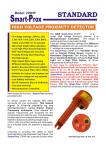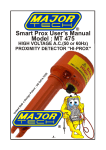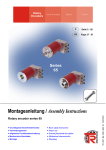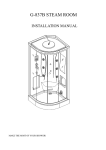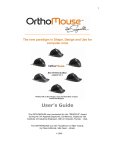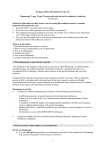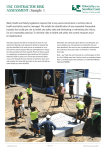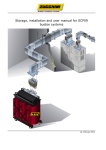Download M7-EN.6 MACHINES M7-EN.6.1 Introduction – operator`s safety M7
Transcript
M7-EN.6 MACHINES M7-EN.6.1 Introduction – operator’s safety M7-EN.6.2 Transport machines M7-EN.6.3 Construction machines M7-EN.6.4 Excavation work M7-EN.6.5 Cranes M7-EN.6.1 Introduction – operator’s safety This chapter presents the typical hazards of contractor work in connection with road works. The aim of the chapter is to − identify and describe the most common hazards − provide the main safety precautions The driver or operator of transport and construction machines must make a daily inspection of the machine and the adjustments needed according to the user’s manual. The driver or operator should be aware of irregularities of any kind in the operation of the machine and immediately report them to his superior. The superior is responsible for bringing the machine in order before work is resumed. Specially trained personnel must carry out all repairs – including the annual overhaul. Overhaul, inspection and maintenance of the machines must ensure that they are kept in proper condition. The annual overhaul should include (among other things) all mechanical parts, hydraulic components, pneumatics, electrical equipment and safety equipment. When checking the bearing parts, it should be stated whether there are signs of crack formations, deformations and loose or damaged construction joints. Paint peeling off can be a sign that the machine has been damaged or overloaded. All transport and construction machines must be provided with a journal, which documents approvals, running inspections and possible repairs. In addition, user manuals and instructions for repair should be kept in or near the machine. Operators and drivers must have in mind that safe equipment operation includes the following practices: − Before starting vehicle, make a walk-around inspection − Test the back-up alarm and other safety devices − Locate and test controls − Know the equipment blind spots and the swing radius − Use equipment seatbelts When entering and exiting the vehicle: − Climb with 3 points of contact to avoid falls − Look for other moving equipment or vehicles − Wipe up grease and fluid equipment on walking/working surfaces − Stay alert and aware of the hazards − Report all repair needs to your supervisor − Always lock out and tag out equipment that cannot be operated − Use personal protective equipment (PPE) supplied and required by your employer − Never use cell phones, AM/FM radios, CD players, or other distractions while operating equipment − Safely secure equipment before using employer provided hand-held cell phones or walkie-talkies − Secure unattended equipment − Lock-out/tag-out prior repairs or maintenance work and set the parking brake and chock the wheels The operators have extra responsibilities. They must: − Know the work zone and their position in it − Know the internal traffic control plan − Use only the designated equipment routes and areas − Identify rollover hazards − Return cones or barricades to their original positions as soon as possible, in case they must be moved M7-EN.6.2 Transport machines The cabins of trucks, cranes, etc. should be arranged so that the driver has a reliable general view of the road and the working area. The cabin should be heated and ventilated, and it should be insulated against noise and vibrations. The driver’s seat should be designed ergonomically, and there should be enough legroom. There should be free and safe access to the cabin or the driver’s seat. Risk factors − Collision − Faulty operation − Cold, noise and vibrations − Heavy work Impact on human health − Collision or faulty operation of machines could result in serious injuries of people and building components. Falling loads or building components can result in further injuries, which might in the end be disabling or deadly. − Cold, noise and vibrations are both tiring and stressful, which may lead to faulty operation or inattentiveness. Long-term impact may result in myalgia, diseases and injuries to body and hearing. − Unsuitably shaped handles or buttons add to the risk of faulty operation and wear down the driver’s back and limbs Safety measures − Take care that the cabin is clean and orderly so steering wheel, handles and buttons can easily be operated. Clean windows improve the view considerably − Use signalman if there is not free view of the road and the load − Take care that handles and buttons are easy to identify and operate − Use the big operating levers for operations, which demand much force, and smaller hand, or finger-operated buttons for precision work. Buttons and handles should not require precision and force simultaneously M7-EN.6.3 Construction machines Construction machines can be used for the transport of people only if they are made for that purpose. Many construction machines must be provided with driver’s protection against overturning and/or against falling objects. The driver should at least possess a tractor driver’s licence. (M7-EN.6-1.jpg) Risk factors − Running over people − Cutting power and gas cables − Skidding and turning over − Caterpillar tracks damaged by frost Impact on human health − Running over people can result in severe injuries − Cutting power and gas cables can result in poisoning or serious electric shock − Caterpillar tracks damaged by frost can cause severe injuries Safety measures − Keep a safe distance from people and avoid swinging above people − Machines with a walking operator should be equipped with operating equipment, which safeguards the operator from being stuck between the machine and fixed objects. The machine must stop when the operator releases the operating equipment − Keep a safe distance to power and gas cables, fixed objects and slopes − Avoid overload − Blades or other mobile parts should be kept low when driving and lowered completely before leaving the machine − Clean the machine daily. Caterpillar tracks should be cleaned particularly carefully during periods of frost M7-EN.6.4 Excavation work Excavation work should be planned. In the planning the quality of the soil is taken into consideration including possible pollution, ground water level, power, gas and communication cables, traffic conditions and other things which may affect safety. (M7-EN.6.2.jpg) Risk factors − Collapse is increased by rain, snow and frost − Falling into the excavation − Existence of slopes Safety measures − During excavation without propping, the sides need a gradient so collapse does not occur − Where sufficient gradient cannot be achieved, propping has to be made according to regulations − Make sure that there are ladders in the excavation and that the necessary escape routes have been established M7-EN.6.5 Cranes For cranes, there are special requirements for testing safety. When cranes are used for the first time, or after rebuilding/alterations, repair or resetting, load tests must be made. The purpose of the load test is to check the strength of the bearing parts including outriggers, beam, jib, roadway or rails as well as securing, consoles, turntable bearings/Rotex gear, etc .As certain safety devices must be set out of action during tests, the tests must always be carried out by special experts. As far as possible, the operator should also be present during the tests. Operating most types of cranes, demands that the operator is trained and certified in using and maintaining the crane. Crane driver’s certificates cannot be issued to persons under the age of 18. A spotter or oiler is somebody who fastens or frees a load from a crane hook. He/The spotter must be instructed for the safe execution of the job and must be at least 18 years old. Spotter and crane driver have the right and duty to refuse lifts they have doubts about the safe operation of the crane. Risk factors − Sink into the soil or skid and tumble − Strong winds that may overturn cranes or bring loads to swing − Faulty set-up or operation − Run over people or buildings, goods or construction parts − Falling or swinging loads − The load may tumble when set down − Defects in fastening devices – or overload − Worn or defective fastening gear Impact on human health − Body or part of body trapped/squeezed − Injuries from falling or swigging loads Safety measures − Tower cranes must always be set up by specially trained personnel − Make sure that the ground of the work area is able to carry the load − Keep a safety distance of at least 0.5 m from buildings, goods or construction parts − Keep the yaw area and possibly the driving area properly closed off − Always make sure that all safety devices are adjusted correctly according to the regulations − During the setting up it is important to control that elevation stop, operational stop, signalling apparatus, etc. function correctly, and that the crane is otherwise correctly equipped − Control that cranes do not collide − Always leave tower cranes with yaw brake loosened so the crane can turn in the wind direction − Be aware of the wind when working with large or light loads. Regardless of the power and stability of the crane, it may be necessary to give up the work even at low wind speed − For mobile cranes outriggers are always used according to the instructions of the manual − On cranes, handles and buttons should return to neutral position when they are released When it comes to spotters, they must always: − Keep an eye contact with the operator during work − Ensure that no one should remain on a load which has been fastened and lifted from the surface − Wear a helmet, safety boots and suitable working gloves − Use the proper fastening gear, and scrap damaged or defective gear − Make sure prior to the lift that the hook is in a vertical position above the centre of gravity of the load, that the load is in balance, that all straps are fastened correctly, and that the load is not stuck in the surface − Make sure that the load cannot turn over before removing the fastening gear





